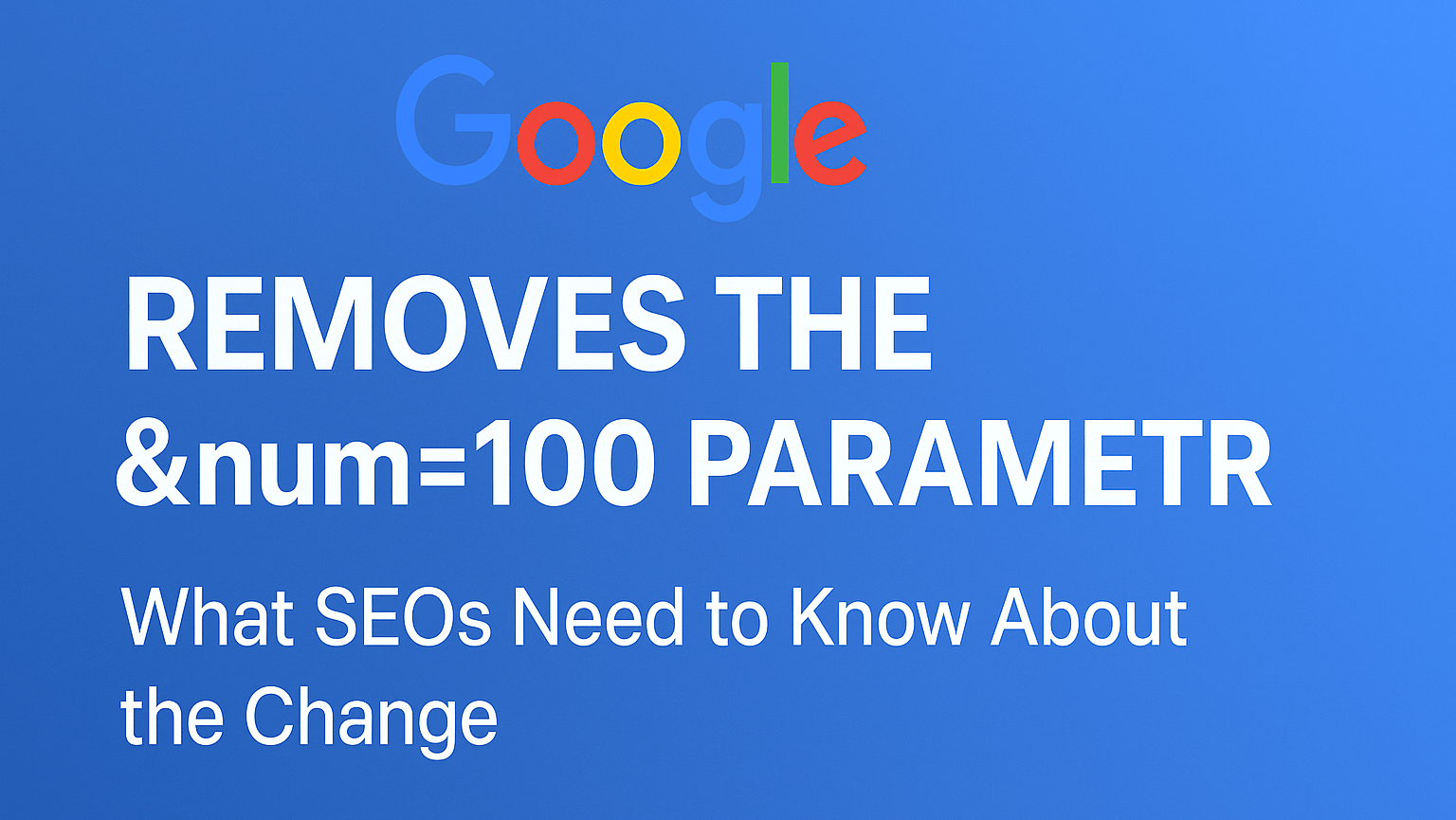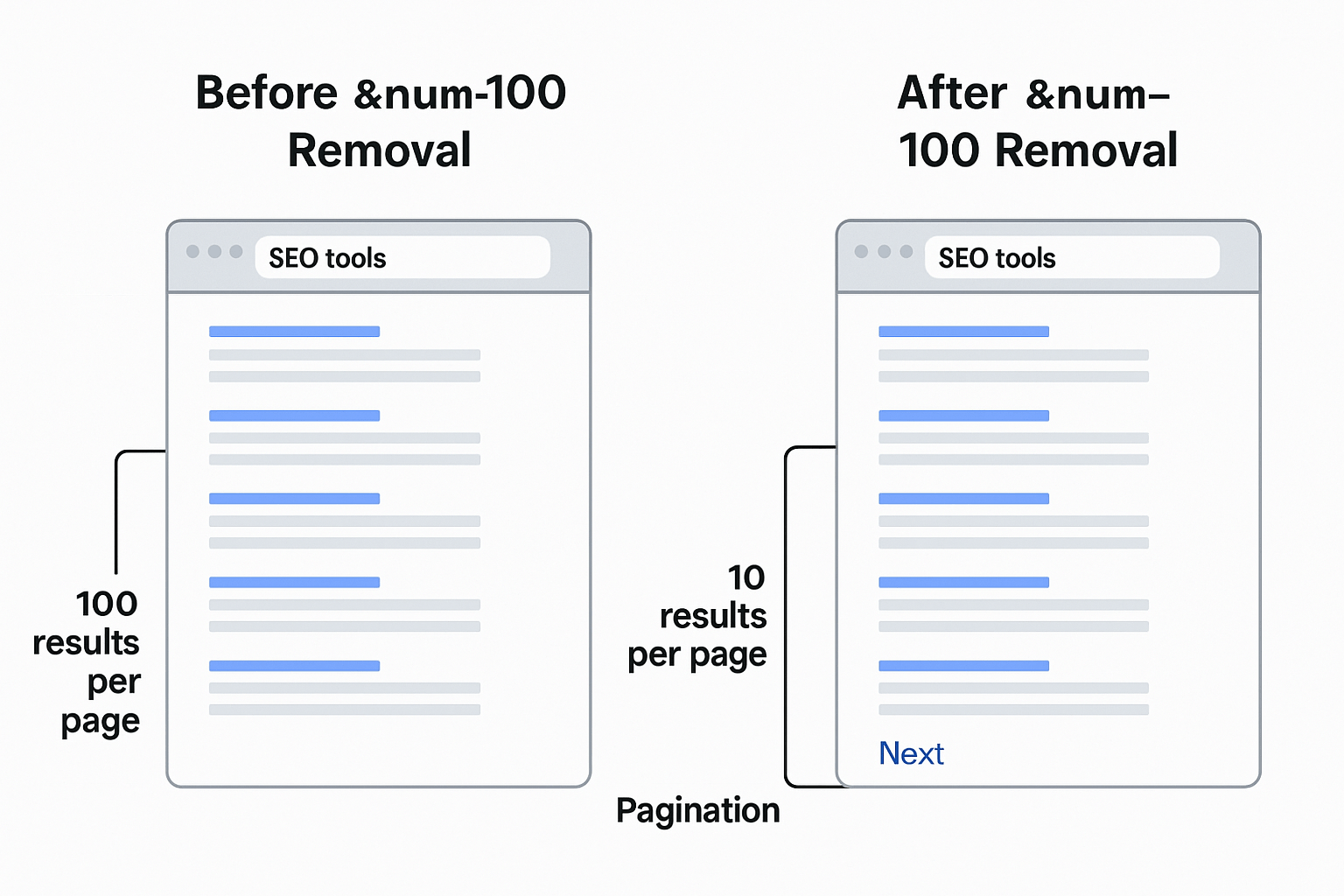
Google Removes the &num=100 Parameter: The End of Bulk SERP Tracking
Google Removes the &num=100 Parameter: The End of Bulk SERP Tracking
The world of SEO is never static. Every so often, Google rolls out a change—sometimes small, sometimes monumental—that disrupts established practices. In September 2025, a quiet but significant adjustment sent ripples across the SEO industry: Google removed support for the &num=100 parameter.
For years, this simple parameter was a hidden workhorse for SEO professionals and tools. It allowed rank trackers to quickly pull 100 results per query, streamlining keyword monitoring and competitor analysis. With its removal, however, SEO platforms, agencies, and in-house marketers are facing challenges in accuracy, reporting, and data interpretation.
In this article, we’ll explore:
- What the
&num=100parameter was and why it mattered - The reasons behind Google’s decision
- How this change impacts SEO tools and marketers
- The broader implications for rank tracking and data reliability
- Practical strategies for adapting to a post-
&num=100world

What Was the &num=100 Parameter?
By default, Google displays 10 results per search page. For everyday users, that makes sense — most searchers rarely go past the first page. But for SEOs, limiting data to 10 results was inefficient.
The &num=100 parameter was a URL modifier that forced Google to display 100 organic results on a single page. For example:
https://www.google.com/search?q=seo+tools&num=100
This feature offered several benefits:
- Efficiency – Tools could fetch 100 results at once instead of paginating through 10 results per page.
- Comprehensive Tracking – Marketers could easily check rankings beyond the first page, capturing positions 11–100.
- Cost Savings for SEO Platforms – Fewer API calls and server requests meant lower infrastructure costs.
- Competitive Analysis – Businesses could quickly assess the top 100 competitors for any keyword.
For rank-tracking platforms like SEMrush, Ahrefs, Moz, BrightLocal, SERanking, AccuRanker, and countless others, this parameter wasn’t just convenient — it was foundational.
Why Did Google Remove It?
Google did not announce or explain this change officially, but industry experts have put forward several plausible reasons.
1. Reducing Server Load
Pulling 100 results per query creates significantly more strain on Google’s systems, especially when done at scale by thousands of SEO tools. By forcing pagination, Google reduces the number of large data requests hitting its servers.
2. Limiting Automated Scraping
Google has long fought against automated data scraping. Since &num=100 made it easy to collect large SERP datasets, its removal discourages mass scraping by SEO tools and data aggregators.
3. Aligning with Real User Behavior
The majority of searchers click results within the first 10 results. By deprecating bulk access to the top 100, Google arguably reinforces the notion that what matters most is visibility in the top results.
4. Data Privacy and Control
Google increasingly wants to control how data is accessed and monetized. By cutting off bulk SERP access, it pushes marketers towards first-party platforms like Google Search Console and Google Ads data.
Immediate Impacts on SEO Tools
The removal of &num=100 has tangible consequences for both SEO platforms and the marketers who rely on them.
- Slower Data Collection
Rank trackers now have to paginate through SERPs in batches of 10. Instead of 1 request per keyword, they now need up to 10 requests. This increases crawl time and infrastructure requirements. - Higher Costs for Providers
With more requests needed, platforms must invest in additional servers and bandwidth. These costs could eventually trickle down to customers via price increases. - Inconsistent Ranking Data
Some tools may not fully capture rankings beyond the top 20 or 30 positions, leading to apparent “missing” data or gaps in reports. - False Signals of Ranking Drops
Marketers may see reports indicating sudden declines in rankings. In reality, the data may simply be incomplete because the tool failed to paginate fully. - Reduced Transparency for Long-Tail Keywords
Long-tail keywords often rank outside the top 10. Without reliable visibility into rankings beyond the first page, some keyword opportunities may go unnoticed.
Example: How Rank Tracking Changes After &num=100 Removal
Before:
- Query: “best running shoes”
- Tool pulls 100 results in a single request
- Your site ranking at position 57 is visible immediately
After:
- Query: “best running shoes”
- Tool pulls 10 results at a time, needing 6 requests to find your position at 57
- If the tool stops after 30 results (to save time/cost), your ranking at 57 may appear “missing”
This means marketers relying on automated tools may misinterpret missing data as a ranking drop.
Broader Implications for SEO Strategy
While this may seem like a technical hiccup, it reflects larger trends in SEO and Google’s direction:
- Less Reliance on Raw Rankings
Rankings are no longer the ultimate metric. Visibility, impressions, CTR, and conversions matter more. - Shift to First-Party Data
Google is nudging marketers toward Search Console, GA4, and Google Ads for performance data. - More Focus on Page One Optimization
With less visibility into deep rankings, businesses may prioritize page-one presence even more aggressively. - Stronger Dependence on Enterprise SEO Tools
Large platforms with resources to handle increased API costs may have an advantage over smaller, niche SEO tools.
How SEOs Should Adapt
Here are actionable steps to minimize disruption:
1. Manage Client Expectations
Explain to stakeholders why reports may look different. Be transparent about missing ranking data and clarify that it doesn’t always reflect real performance drops.
2. Use Google Search Console Smarter
- Analyze average position trends
- Use impression data to understand how often you appear beyond page one
- Segment by query type (short-tail vs long-tail keywords)
3. Cross-Check Multiple Tools
Don’t rely on a single platform for rank tracking. Cross-referencing across tools like SEMrush, Ahrefs, and GSC can help fill data gaps.
4. Focus on Page-One SEO
Since traffic primarily comes from the top 10 results, double down on strategies that improve click-through rate (CTR), featured snippets, and SERP features.
5. Reframe Success Metrics
Move the conversation away from “I rank #54” to more impactful KPIs like organic traffic growth, conversions, lead quality, and revenue impact.
Historical Context: Other Google Changes Affecting SEOs
The removal of &num=100 is not the first time Google has disrupted SEO tracking. A few key milestones include:
- 2013: [Not Provided] Keywords – Google encrypted search queries, hiding most keyword data in Analytics.
- 2015: Mobilegeddon – Mobile-friendliness became a ranking factor, pushing marketers to optimize for mobile-first.
- 2020: Passage Indexing & Core Web Vitals – Emphasis shifted toward user experience and granular content relevance.
- 2023: Bard & Generative Search (SGE) – AI reshaped how users engage with SERPs, reducing clicks to traditional organic results.
Each time, SEOs adapted — and this time is no different.
Looking Ahead: The Future of Rank Tracking
Will rank tracking die? Not quite — but it will evolve.
- Less Emphasis on Deep Rankings – Expect tools to report primarily on the top 10–20 positions.
- More Investment in Impression-Based Metrics – Marketers will track how often they’re visible, not just where they rank.
- AI-Powered Tracking – Tools may shift to AI-driven analysis of SERP features (snippets, People Also Ask, video packs, etc.).
- Closer Ties to PPC – SEO and SEM data will integrate more closely as Google centralizes data within its ad ecosystem.
Conclusion
The removal of the &num=100 parameter is a technical change with wide-reaching implications. While it makes rank tracking more difficult, it also reinforces a truth many SEOs already know: rankings alone are not the full picture.
Successful SEO is about more than position — it’s about visibility, clicks, and business outcomes. By adapting strategies, reframing KPIs, and leveraging first-party data, marketers can continue to thrive in this new landscape.
As always in SEO, change is the only constant. The winners are those who adapt quickly.

